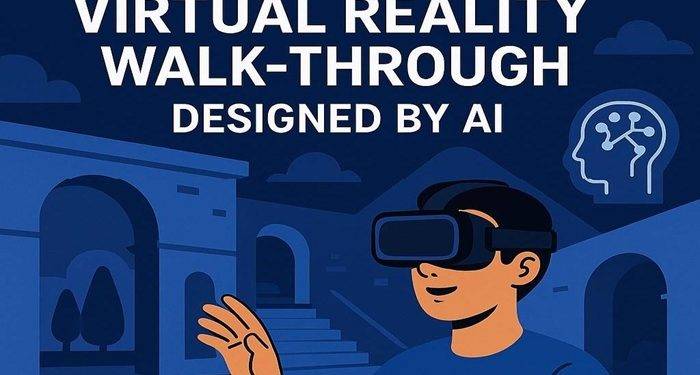In recent years, the gaming industry has witnessed a revolutionary change with the advent of virtual reality walkthroughs designed by AI. This fusion is redefining the boundaries of interactive entertainment, offering unprecedented levels of immersion and realism. By leveraging AI, developers can create dynamic environments that adapt to players’ actions, enhancing the narrative depth and engagement levels of virtual tours. This adaptability provides players with a sense of agency and influence over the game world, making each experience unique and personalized.
The concept of virtual reality walkthroughs is not novel, but when augmented by AI, these experiences become more than a mere depiction of reality—they evolve into dynamic, interactive realms that respond to user input in real-time. This capability elevates the role of a virtual reality game developer, as they must now consider not only the visual and narrative elements but also the AI-driven mechanisms that underpin the gameplay. To successfully navigate this new landscape, it’s crucial to hire a virtual reality developer who can harness AI’s predictive capabilities to anticipate player behavior, creating a seamless blend of scripted and emergent gameplay elements. This shift necessitates a rethinking of traditional game design approaches, where static environments give way to fluid, player-driven experiences.
Key Takeaways
- Immersive Experiences: AI-designed virtual reality walkthroughs provide an unparalleled level of immersion and interactivity, setting new standards for gaming experiences.
- Dynamic Environments: Unlike static experiences, AI allows VR environments to evolve based on user interactions, enhancing player agency and engagement.
- Role of Developers: The integration of AI requires specialized skills, making it essential to hire a virtual reality developer who can adeptly blend narrative and gameplay mechanics.
- Future of Game Design: The use of AI in VR is reimagining traditional game design, promoting fluid, adaptable experiences that encourage player-driven storytelling.
- Community Engagement: AI-designed VR experiences foster deeper connections within the gaming community, encouraging discussions and collaboration around gameplay and narratives.
AI’s Role in Enhancing VR Experiences
AI’s integration into VR experiences offers several key benefits that enhance the overall gaming experience. Firstly, AI algorithms enable the development of adaptive environments that change in response to player interactions. This means that each user’s journey through a virtual reality walkthrough is unique, fostering a sense of agency and immersion that static experiences cannot match. The ability of AI to adjust difficulty levels and narrative outcomes based on player behavior ensures that both casual players and hardcore enthusiasts find the experience challenging and rewarding.
Additionally, AI-driven analytics provide developers with insights into player behaviors and preferences. By analyzing data generated during gameplay, developers can refine their designs and create more engaging and intuitive experiences. This feedback loop is invaluable for game developers aiming to create immersive worlds that resonate with players. Moreover, these insights can inform future updates and expansions, allowing developers to continuously evolve their games in alignment with player expectations and technological advancements.
The Intricacies of AI-Driven VR Walkthroughs
Creating AI-driven VR walkthroughs requires a deep understanding of both AI algorithms and VR technology. Developers must consider several factors to ensure that these experiences are seamless and captivating. Balancing technical performance with creative storytelling is essential to maintaining player immersion and engagement. The challenges lie in integrating AI seamlessly into the fabric of the game without detracting from the narrative experience.
Designing Dynamic Narratives
One of the most significant challenges in crafting AI-driven VR experiences is developing dynamic narratives that respond to player choices. Unlike traditional games with linear storylines, AI-designed walkthroughs require branching narratives that adapt in real-time. This necessitates a meticulous approach to story development, where each decision point is carefully crafted to maintain narrative coherence while allowing for player agency. The complexity of these branching paths requires sophisticated AI systems capable of managing numerous variables and potential outcomes.
Moreover, the integration of AI into narrative design facilitates the creation of characters that exhibit lifelike behaviors and emotions. By employing machine learning algorithms, developers can imbue non-playable characters (NPCs) with the ability to learn from player interactions, resulting in more authentic and engaging interactions. These adaptive characters can respond differently to various players, providing a personalized experience that feels genuinely reactive and alive. This level of interactivity can lead to deeper emotional connections between players and the virtual characters they encounter.
Optimizing Realism and Immersion
To achieve a truly immersive experience, developers must optimize both the visual and auditory elements of AI-driven VR walkthroughs. This involves leveraging AI to enhance graphical fidelity, ensuring that virtual environments are as lifelike as possible. Techniques such as procedural generation allow for the creation of intricate and detailed landscapes that evolve dynamically, further enhancing realism. These technologies enable the creation of vast, explorable worlds that maintain high levels of detail without requiring exorbitant development resources.
Furthermore, AI-driven audio design is critical in crafting a multisensory experience. By analyzing player movements and interactions, AI can dynamically adjust audio cues to match the virtual environment’s context, heightening immersion and emotional impact. Soundscapes can be tailored to the player’s actions and decisions, creating a more cohesive and believable world. This attention to auditory detail complements the visual experience, creating a fully immersive environment that envelops the player in the game world.
Implications for Game Developers and Industry Stakeholders
The advent of AI-designed VR walkthroughs has significant implications for game developers and industry stakeholders. As the demand for immersive experiences continues to grow, developers must adapt to this evolving landscape to remain competitive. Embracing these technologies can lead to the creation of games that are not only more engaging but also more profitable, as they attract a wider audience and encourage longer playtimes.
Enhancing Development Processes
For game developers, the integration of AI into VR development processes requires a shift in approach. Traditional development models must be augmented with AI-driven methodologies to accommodate the dynamic nature of these experiences. This involves incorporating machine learning algorithms into the development pipeline, enabling real-time adjustments and refinements based on player feedback. Developers must also invest in new tools and technologies that facilitate the seamless integration of AI into their existing workflows.
Moreover, the complexity of AI-driven VR experiences necessitates collaboration between multidisciplinary teams, including AI specialists, narrative designers, and VR developers. This collaborative approach ensures that all aspects of the experience are seamlessly integrated, resulting in cohesive and engaging virtual tours. Cross-disciplinary collaboration fosters innovation and allows for the exchange of ideas that push the boundaries of what is possible in game development.
Fostering Innovation and Collaboration
The convergence of AI and VR also fosters innovation and collaboration within the gaming industry. As developers explore new possibilities enabled by AI, they are encouraged to experiment with novel gameplay mechanics and narrative structures. This spirit of innovation extends beyond individual studios, as industry stakeholders collaborate to develop standardized tools and frameworks that facilitate the creation of AI-driven VR experiences. These collaborations can lead to the establishment of best practices and shared technologies that benefit the entire industry.
Engaging the Gaming Community through AI-Designed VR
The emergence of AI-designed VR walkthroughs opens new avenues for engaging the gaming community. These experiences offer players unparalleled levels of immersion and interactivity, sparking discussions and debates within the gaming community. The ability to deeply engage with content encourages players to invest more time and emotion into their gaming experiences, creating a vibrant and active community.
Sparking Debates and Discussions
Video game journalists and content strategy managers have an opportunity to leverage AI-designed VR experiences to craft engaging narratives that captivate readers. By exploring the intricate details and mechanics of these walkthroughs, journalists can provide in-depth analysis and commentary that sparks debates and discussions within the gaming community. These discussions can focus on the ethical implications of AI in gaming, the evolution of storytelling techniques, or the technological advancements driving these experiences.
Moreover, the dynamic nature of AI-driven experiences allows for the exploration of complex themes and moral dilemmas, encouraging players to reflect on their choices and engage in meaningful conversations. These discussions can extend beyond the gaming community, attracting interest from broader audiences interested in the intersection of technology, art, and human behavior.
Fostering Community Interaction
For content strategy managers at gaming companies, AI-designed VR experiences present an opportunity to foster community interaction and engagement. By creating platforms for players to share their experiences and insights, companies can cultivate a sense of community and belonging among their audience. These platforms can include forums, social media groups, and in-game events that encourage player interaction and collaboration.
Additionally, user-generated content and mods can enhance the longevity of AI-driven VR experiences, encouraging players to contribute to the evolution of these virtual worlds. By supporting modding communities and providing tools for content creation, developers can harness the creativity of their player base to enrich the game world and sustain player interest over time.
The integration of AI with VR is ushering in a new era of immersive gaming experiences. As AI-designed VR walkthroughs become more prevalent, game developers, journalists, and content strategists must adapt to this evolving landscape. By embracing the possibilities offered by AI, the gaming industry can create dynamic, engaging, and thought-provoking experiences that captivate players and inspire meaningful interactions within the gaming community. The potential for innovation is vast, with AI and VR poised to redefine the limits of interactive entertainment.
As we move forward, the collaboration between AI and VR will continue to redefine the boundaries of interactive entertainment, paving the way for a future where immersive experiences are limited only by our imagination. The ongoing dialogue between technology and creativity will shape the next generation of gaming, offering players experiences that are richer, more complex, and more engaging than ever before.
FAQ
What are virtual reality walkthroughs?
Virtual reality walkthroughs are interactive experiences that allow users to explore virtual environments in a simulated reality, often enhancing the realism through advanced technology.
How does AI enhance virtual reality walkthroughs?
AI augments virtual reality walkthroughs by creating dynamic environments that adjust to player interactions. It enables adaptive storytelling and character behaviors, providing a personalized and immersive gaming experience.
Why is it important to hire a virtual reality developer?
Hiring a virtual reality developer is crucial because they possess the skills required to integrate AI’s capabilities into VR experiences. They can design engaging environments and gameplay that respond to player actions in real-time.
What are the benefits of AI-driven VR experiences?
AI-driven VR experiences offer benefits such as personalized narratives, adaptive difficulty, and improved gameplay analytics. These features lead to more immersive and engaging player interactions.
How do AI-driven experiences impact game development?
They necessitate a shift in traditional game development approaches, encouraging collaboration among diverse teams and the use of AI technologies to create dynamic, player-driven experiences.








